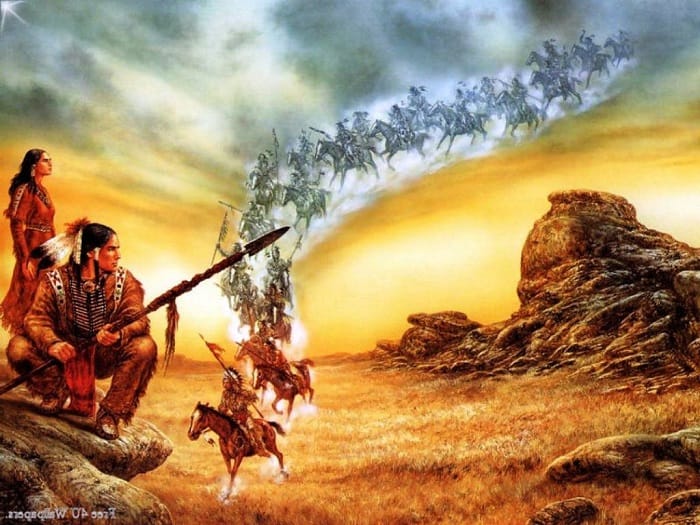Native American essay part 2
In the 1830’s, Native Americans still lived in their native lands for the most part. However, white men considered them a threat to peace. So, in 1838, the Federal government had what they called the “Five Civilized Tribes” removed (Briggs & Pittman, 1997). These tribes were the Cherokee, Choctaw, Chickasaw, Creek, and Seminole. They were moved at a forced march up to 800 miles from their homelands to the “Indian Territory”, which is modern-day Oklahoma. Under cruel conditions, the army forced the peaceful tribes through the cold, winter weather to their new homes (Hertz, 2004). During this ordeal, known as the “Trail of Tears”, over 4,000 Cherokees alone died, out of the 15,000 moved (Billings, 2002). However, the removal of Native Americans had proved to be disastrous for them because they died due to disease, exposure, and starvation. The conditions of the removal were unbearable and Native Americans could not physically survive the relocation. More important, the relocation was poorly managed since Native Americans were just forced out of their land, they had got the destination and the land, where they had the right to settle, and all the rest was virtually up to Native Americans, how to relocate without any support from the part of the government or white Americans.
Even when the Indian Territory was reached, the US Government was not satisfied. Slowly, more and more of the land was taken from the Native American tribes. A government who maintained ideas of equality and freedom, were showing that these ideas obviously did not pertain to everyone. In 1902, several hundred thousand acres were cleared out for white settlements (McCary, 2010). In 1907, the Indian Nations ceased to exist, and when Oklahoma became a state, all Native American territory was assimilated into the Union (Rountree, 2005).
Naturally, Native Americans were unwilling to obey to decisions taken by the white officials because they still believed that their land belonged to them and they were the native population of America and, thus, they were not going to give in their land to white Americans just because the US Congress decided so. In fact, the increasing pressure of the US government on Native Americans resulted in the open military conflict between Native Americans and white Americans. The series of bloody battles started several years after the end of the Civil War, due to the demand of Indian territory by the white Americans and ended with the massacre at Wounded Knee in 1890 (Egloff & Woodward, 2001). Thousands of Native Americans were slaughtered by the cruel Union Army, led by generals such as Custer, Gabon, and Sherman. The Native Americans, led by heroes such as Sitting Bull, Chief Joseph, and Crazy Horse, fought outnumbered for many years before being defeated one by one at the hands of the Federal Government (Potter, 1993). They won many battles, such as the Kidder massacre, in which they killed an entire regiment, with only 2 casualties themselves (Holton, 2000). However, such achievements only enhanced the pressure on Native Americans and provided the US government with the support of the public opinion because white Americans grew certain that Native Americans were dangerous.
For the most part, however, the Union was a ruthless enemy. They attacked many harmless villages, and killed many Native Americans in the massacres of Powder River, Sand Creek, Little Wolf, and Wounded Knee (Nash, 1999). The Native Americans were outnumbered and outgunned. By the end of the war, they had won many battles against the Union Army, but they also lost so many warriors that they were forced to surrender (Rountree, 2005). Eventually, Native Americans’ resistance faded away as they could not resist to the overwhelming power of the US. Native Americans could not confront the well-trained army and defeat it. This is why they were forced out of their land, but they lost not only their land but also many Native Americans lost their life. Today, the removal of Native Americans is perceived as a humanitarian catastrophe managed by the US government, but, in that time, it was perceived as the operation aiming at securing western frontier of the US and as the only effective way to eliminate the Indian threat.
However, this threat was ephemeral and rather imagined than real. As the film Soldier Blue shows the threat was imagined by white Americans because they did not understand Native Americans. More important, they did not want to negotiate or develop closer relations with Native Americans neither. Instead, they preferred to eliminate Native American physically, either through their removal or through their slaughtering. In this regard, the understanding of motives of white Americans justifies, to a certain extent, their actions. At any rate, the film and conclusions that has been just made from this film allow viewing the oppression of Native Americans by white Americans not as the manifestation of the ultimate cruelty and a genocide attempt but, instead, it may be viewed as actions driven by sheer fear of white Americans, who did not know Native Americans and it was the fear that determined their actions and oppression of Native Americans.
Thus, the complexity of relationships between white Americans and native Americans was, to a significant extent, determined by the fear and oppression as the major drivers of the tension between them. White Americans did not know Native Americans, their culture and lifestyle but their traditions appalled then. This is why they viewed Native Americans as a threat and attempted to remove them from the western frontier. However, Native Americans naturally resisted because they were eager to protect their land. As a result, the US Congress took the decision on the removal of Native Americans, who were later settled in reservations.
Do you like this essay?
Our writers can write a paper like this for you!




 (2 votes, average: 4.50 out of 5)
(2 votes, average: 4.50 out of 5)